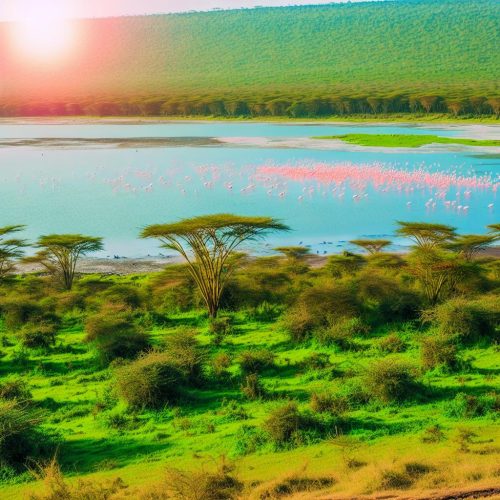Overview of Lake Nakuru National Park
Lake Nakuru National Park, situated in central Kenya, represents a region of remarkable beauty and ecological richness. Encompassing an area of approximately 188 square kilometers, the park’s defining feature is Lake Nakuru, a shallow and alkaline lake teeming with life. The Kenya Wildlife Service manages this significant protected area, which has also been honored as a UNESCO World Heritage Site, highlighting its crucial ecological role and the diverse range of species it supports.
Geographical Features
The geographical diversity within Lake Nakuru National Park is significant, featuring vast escarpments, expansive grasslands, and dense wooded areas. Each of these environments plays a critical role in supporting a variety of fauna and flora. These varied ecosystems provide an ideal setting for a wide range of species, offering habitats that cater to the different needs of wildlife residing in this area. The lake itself serves as an essential component of the park, acting as a vital feeding ground specifically for the avian population, including numerous species of birds that find sustenance and shelter on its shores.
Rich Biodiversity
The park is famed for its rich biodiversity, making it a preferred destination for wildlife enthusiasts and biologists alike. Among the numerous species residing here are the endangered Rothschild giraffes, a striking example of conservation success, as well as populations of black and white rhinos that draw considerable attention for their rarity and conservation status. Additionally, other large mammal species such as buffalos and waterbucks thrive in the park’s nurturing habitats. Notably, Lake Nakuru National Park also supports apex predators like lions and leopards, which coexist within this complex web of life, maintaining the essential balance required for a robust ecosystem.
The Flamingo Phenomenon
A distinctive highlight of Lake Nakuru National Park is the flamingo population that dramatically beautifies the landscape. Lake Nakuru hosts two predominant species of flamingos: the Lesser Flamingo and the Greater Flamingo. These birds are attracted to the lake in immense flocks, often numbering in the thousands, creating a stunning visual tableau of pink that contrasts against the serene blue of the lake waters. The spectacle of these birds feeding and roosting is not merely a visual delight but a significant ecological event that showcases the complex interactions within this ecosystem.
Causes of Migration
The migration patterns of flamingos to Lake Nakuru are primarily governed by the availability of food sources, specifically algae that proliferate in the lake’s alkaline water environment. Flamingos are highly dependent on this algae, and their presence in the park is a fine-tuned response to the ecological parameters that support these food supplies. Changes in water levels, often dictated by climatic fluctuations, further influence these patterns, affecting the population dynamics of the flamingo flocks. To delve deeper into the migratory behaviors and population variations of flamingos at Lake Nakuru, one might consult dedicated African wildlife resources, such as BirdLife International, for comprehensive studies and insights.
Conservation Challenges
The park is not without its challenges, especially concerning environmental threats that arise from both natural and anthropogenic sources. Pollution poses a significant concern, primarily originating from urban expansion and adjacent agricultural activities. Such developments can lead to siltation in the lake and surrounding water bodies, thereby threatening the delicate habitats of resident species, including the famous flamingos. Conservation efforts are underway to address these issues, driven by a commitment to implementing sustainable practices that aim to reverse or mitigate the detrimental impacts facing this critical ecosystem.
Visiting Lake Nakuru National Park
For those eager to explore Lake Nakuru National Park, various activities are available that cater to diverse interests. Visitors can embark on game drives through the park’s terrain, offering opportunities to observe wildlife in their natural habitat. Bird watchers, in particular, find joy in the multiplicity of avian life, with ample opportunities to witness both common and rare species up close. Additionally, guided nature walks are an excellent way to engage with the landscape, providing an immersive educational experience that combines leisure with learning.
The park’s proximity to Nairobi makes it an accessible and attractive option for travelers, whether they are local or international tourists seeking a retreat into nature. By appreciating the ecological significance of Lake Nakuru National Park and its myriad inhabitants, visitors not only enrich their understanding of this unique habitat but also contribute to the ongoing conservation endeavors crucial for sustaining this biome’s vitality. Preservation efforts ensure the continuity of these natural wonders, allowing future generations to witness and cherish the beauty and biodiversity of Lake Nakuru National Park.
